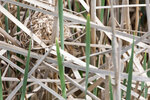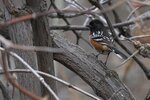



Every year someone will ask me, “What are you going to do for Earth Day?” For the past 21 years, my answer has been basically the same. You see, my son Aaron’s birthday is April 14 and each year since he was one, we celebrate by finding a blooming red-flowering currant bush and taking an annual photo. We have a more-or-less complete 21-year catalog of a growing Aaron and blooming currants.
Some huge currants are to be found at the Billy Frank Nisqually National Wildlife Refuge, and this Earth Day, Aaron and I plan to spend several hours there. We will stop by the currant bushes, and I suspect there we will find hummingbirds, both the Anna’s and Rufous species. They just love those bushes this time of year.
Another bird we expect to encounter is the Marsh Wren. This bird is common in and near the Nisqually area wetlands. Both sexes appear identical, a tiny bird with a round body and thin bill. Usually, it will hold its tail straight up from its back. It is brown overall, with a pale breast and a distinctive white strip above its eye. Also, it has tiny alternating black and white feathers on its back.
But far and away, this bird is best known to birders by its song. That’s because, although common, it is secretive and hides from view among the cattails where it often nests. Sometimes beginning with a “chuck” note, males go on to sing a series of buzzy trills and gurgling notes. At times they may go on for up to 20 minutes, seldom repeating the same notes or song patterns. Some writers consider the Marsh Wren to be the most prolific of singers, having recorded a single male singing at least 18 separate and distinct songs. That’s quite a vocal repertoire!
Male Marsh Wrens spring activities are not limited to singing. They are also the species’ nest builders. Once a male has established his territory, he will build a large (5-7”) dome-shaped nest of strips of cattail or other reeds or grasses. In fact, he may build several such nests in anticipation of attracting a female breeding partner. Once she has accepted the nest, she lines it with various soft materials and begins laying eggs, sometimes up to 10 of them.
Males do not limit themselves to one female, incidentally, sometimes breeding with multiple females that have been attracted to a male’s singing prowess and architectural skills.
I am from Central Ohio and grew up in the Midwest. I never considered that we mid-westerners had much of an accent. But, living out here in Washington for many decades now, I sometimes encounter a person who just sounds “normal,” and I immediately have an affinity with them. Almost always, I later learn that they were raised in the Midwest too. Somehow, I find the vocal quality of other Midwesterners – the quality I grew up with - appealing.
So, does that casual personal observation hold any insights about birds? Maybe so. Each winter, a team does the Christmas Bird Count in a part of northeast Thurston County we generally call Johnson Point. Years ago, Bill Tweit, a very knowledgeable birder with an excellent ear for bird calls, told me that the Spotted Towhees he was hearing on the count sounded different from towhees further south in the county. Others with good ears have also heard this distinction, and we started calling them Johnson Point Towhees.
Eventually Bill took recording equipment out to the Johnson Point area and elsewhere in the south county. He also created sonograms that documented the differences, and they were significant. It turns out that here in Thurston County, we have an emerging dialect of Spotted Towhee vocalizations.
What does it mean? It might be like the Midwest accents. Young raised by towhees singing the Johnson Point dialect find it more familiar and appealing and thus, through the years, males singing this dialect have developed a competitive breeding advantage. Not long ago, a friend told me that she heard a strange-sounding towhee on the northern end of the Chehalis Western trail. It may be that Johnson Point towhees are moving south and west and, over time, will expand well beyond their initial limited territory.
George Walter is environmental program manager at the Nisqually Indian Tribe’s natural resources department; he also has a 40+ year interest in bird watching. He may be reached at george@theJOLTnews.com
Photos for this column are provided by Liam Hutcheson, a 15-year-old Olympia area birder and avid photographer.
Comments
No comments on this item Please log in to comment by clicking here